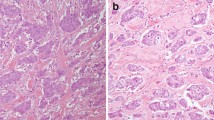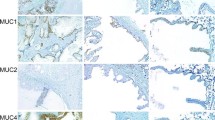Abstract
Salivary duct carcinoma is a highly aggressive salivary gland malignancy that may be misdiagnosed as high-grade mucoepidermoid carcinoma. We utilized tissue microarrays with 78 examples of mucoepidermoid carcinoma and 47 salivary duct carcinomas to evaluate the utility of an immunohistochemical panel consisting of androgen receptor, Her2/neu, p63, and cytokeratin 5/6 in distinguishing these entities. Among all cases in the cohorts, androgen receptor was highly specific for salivary duct carcinoma, while cytokeratin 5/6 and p63 were specific for mucoepidermoid carcinoma. While the rate of unequivocal Her2/neu overexpression among the salivary duct carcinomas was low (8.9 %), discrimination of salivary duct carcinoma was enhanced when this marker was used in combination with androgen receptor due to profound sensitivity. The immunohistochemical panel was particularly efficacious at distinguishing the problematic subset of high-grade mucoepidermoid carcinomas from salivary duct carcinoma. Utilization of this set of immunohistochemical markers allows reliable differentiation of salivary duct and mucoepidermoid carcinoma, a distinction with important prognostic and therapeutic implications.

Similar content being viewed by others
References
Brandwein-Gensler MS, Skálová A, Nagao T. Salivary duct carcinoma. In: Eveson JW, Reichart P, Sidransky D, Barnes L, editors. World Health Organization classification of tumours. Pathology and genetics of head and neck tumours. Lyon: IARC Press; 2005. p. 236–7.
Hosal AS, Fan C, Barnes L, Myers EN. Salivary duct carcinoma. Otolaryngol Head Neck. 2003;129(6):720–5.
Barnes L, Rao U, Krause J, Contis L, Schwartz A, Scalamogna P. Salivary duct carcinoma: part I. A clinicopathologic evaluation and DNA image analysis of 13 cases with review of the literature. Oral Surg Oral Med Oral Pathol. 1994;78(1):64–73.
Brandwein MS, Jagirdar J, Patil J, Biller H, Kaneko M. Salivary duct carcinoma (cribriform salivary carcinoma of excretory ducts): a clinicopathologic and immunohistochemical study of 12 cases. Cancer. 1990;65(10):2307–14.
Lewis JE, McKinney BC, Weiland LH, Ferreiro JA, Olsen KD. Salivary duct carcinoma: clinicopathologic and immunohistochemical review of 26 cases. Cancer. 1996;77(2):223–30.
Fan C, Melhem MF, Hosal AS, Grandis JR, Barnes EL. Expression of androgen receptor, epidermal growth factor receptor, and transforming growth factor α in salivary duct carcinoma. Arch Otolaryngol. 2001;127(9):1075–9.
Fan C, Wang J, Barnes EL. Expression of androgen receptor and prostatic specific markers in salivary duct carcinoma: an immunohistochemical analysis of 13 cases and review of the literature. Am J Surg Pathol. 2000;24(4):579–86.
Simpson RHW, Clarke TJ, Sarsfield PTL, Babajews AV. Salivary duct adenocarcinoma. Histopathology. 1991;18(3):229–35.
Moriki T, Ueta S, Takahashi T, Mitani M, Ichien M. Salivary duct carcinoma: cytologic characteristics and application of androgen receptor immunostaining for diagnosis. Cancer Cytopathol. 2001;93(5):344–50.
Hellquist HB, Karlsson MG, Nilsson C. Salivary duct carcinoma—a highly aggressive salivary gland tumour with overexpression of c-erbB-2. J Pathol. 1994;172(1):35–44.
Delgado R, Vuitch F, Albores-Saavedra J. Salivary duct carcinoma. Cancer. 1993;72(5):1503–12.
Williams MD, Roberts D, Blumenschein GR, et al. Differential expression of hormonal and growth factor receptors in salivary duct carcinomas: biologic significance and potential role in therapeutic stratification of patients. Am J Surg Pathol. 2007;31(11):1645–52.
Simpson RHW, Prasad AR, Lewis JE, Skálová A, David L. Mucin-rich variant of salivary duct carcinoma: a clinicopathologic and immunohistochemical study of four cases. Am J Surg Pathol. 2003;27(8):1070–9.
Barnes L, Rao U, Contis L, Krause J, Schwartz A, Scalamogna P. Salivary duct carcinoma: part II. Immunohistochemical evaluation of 13 cases for estrogen and progesterone receptors, cathepsin D, and c-erbB-2 protein. Oral Surg Oral Med Oral Pathol. 1994;78(1):74–80.
Felix A, El-Naggar AK, Press MF, et al. Prognostic significance of biomarkers (c-erbB-2, p53, proliferating cell nuclear antigen, and DNA content) in salivary duct carcinoma. Hum Pathol. 1996;27(6):561–6.
Martinez-Barba E, Cortes-Guardiola JA, Minguela-Puras A, Torroba-Caron A, Mendez-Trujillo S, Bermejo-Lopez J. Salivary duct carcinoma: clinicopathological and immunohistochemical studies. J Cranio-Maxillofac Surg. 1997;25(6):328–34.
Jaehne M, Roeser K, Jaekel T, Schepers JD, Albert N, Löning T. Clinical and immunohistologic typing of salivary duct carcinoma: a report of 50 cases. Cancer. 2005;103(12):2526–33.
Etges A, Pinto DS Jr, Kowalski LP, Soares FA, Araújo VC. Salivary duct carcinoma: immunohistochemical profile of an aggressive salivary gland tumour. J Clin Pathol. 2003;56(12):914–8.
Nabili V, Tan JW, Bhuta S, Sercarz JA, Head CS. Salivary duct carcinoma: a clinical and histologic review with implications for trastuzumab therapy. Head Neck. 2007;29(10):907–12.
Cornolti G, Ungari M, Morassi ML, et al. Amplification and overexpression of HER2/neu gene and HER2/neu protein in salivary duct carcinoma of the parotid gland. Arch Otolaryngol. 2007;133(10):1031–6.
McHugh JB, Visscher DW, Barnes EL. Update on selected salivary gland neoplasms. Arch Pathol Lab Med. 2009;133(11):1763–74.
Skálová A, Stárek I, Vanecek T, et al. Expression of HER-2/neu gene and protein in salivary duct carcinomas of parotid gland as revealed by fluorescence in situ hybridization and immunohistochemistry. Histopathology. 2003;42(4):348–56.
Williams MD, Roberts DB, Kies MS, Mao L, Weber RS, El-Naggar AK. Genetic and expression analysis of HER-2 and EGFR genes in salivary duct carcinoma: empirical and therapeutic significance. Clin Cancer Res. 2010;16(8):2266–74.
Sugano S, Mukai K, Tsuda H, et al. Immunohistochemical study of c-erbB-2 oncoprotein overexpression in human major salivary gland carcinoma: an indicator of aggressiveness. Laryngoscope. 1992;102(8):923–7.
Leecy T, Buckland ME, Turner J, Earls P. The use of immunohistochemistry in the diagnosis of primary salivary duct carcinoma: three case reports. Pathology. 2008;40(4):434–7.
Jamal AM, Zhi-Jun S, Xin-Ming C, Yi-Fang Z. Salivary duct carcinoma of the parotid gland: case report and review of the literature. J Oral Maxillofac Surg. 2008;66(8):1708–13.
Prat A, Parera M, Reyes V, et al. Successful treatment of pulmonary metastatic salivary ductal carcinoma with trastuzumab-based therapy. Head Neck. 2008;30(5):680–3.
Nashed M, Casasola RJ. Biological therapy of salivary duct carcinoma. J Laryngol Otol. 2009;123(2):250–2.
Jaspers HCJ, Verbist BM, Schoffelen R, et al. Androgen receptor-positive salivary duct carcinoma: a disease entity with promising new treatment options. J Clin Oncol. 2011;29(16):e473–6.
Krishnamurthy J, Krishnamurty DM, Baker JJ, Zhen W, Lydiatt D, Ganti AK. Salivary duct carcinoma responding to trastuzumab-based therapy: case report and review of the literature. Head Neck. 2013;. doi:10.1002/hed.23307.
Soper MS, Thompson LDR, Iganej S. Definitive treatment of androgen receptor-positive salivary duct carcinoma with androgen deprivation therapy and external beam radiotherapy. Head Neck. 2013;. doi:10.1002/hed.23383.
Griffith CC, Seethala RR, Luvison A, Miller M, Chiosea SI. PIK3CA mutations and PTEN loss in salivary duct carcinomas. Am J Surg Pathol. 2013;37(8):1201–7.
Goode RK, El-Naggar AK. Mucoepidermoid carcinoma. In: Eveson JW, Reichart P, Sidransky D, Barnes L, editors. World Health Organization classification of tumours. Pathology and genetics of head and neck tumours. Lyon: IARC Press; 2005. p. 219–20.
Goode RK, Auclair PL, Ellis GL. Mucoepidermoid carcinoma of the major salivary glands: clinical and histopathologic analysis of 234 cases with evaluation of grading criteria. Cancer. 1998;82(7):1217–24.
Rapidis AD, Givalos N, Gakiopoulou H, et al. Mucoepidermoid carcinoma of the salivary glands: review of the literature and clinicopathological analysis of 18 patients. Oral Oncol. 2007;43(2):130–6.
Guzzo M, Andreola S, Sirizzotti G, Cantu G. Mucoepidermoid carcinoma of the salivary glands: clinicopathologic review of 108 patients treated at the National Cancer Institute of Milan. Ann Surg Oncol. 2002;9(7):688–95.
Kokemueller H, Brueggemann N, Swennen G, Eckardt A. Mucoepidermoid carcinoma of the salivary glands—clinical review of 42 cases. Oral Oncol. 2005;41(1):3–10.
Brandwein MS, Ivanov K, Wallace DI, et al. Mucoepidermoid carcinoma: a clinicopathologic study of 80 patients with special reference to histological grading. Am J Surg Pathol. 2001;25(7):835–45.
Tonon G, Modi S, Wu L, et al. t(11;19)(q21;p13) translocation in mucoepidermoid carcinoma creates a novel fusion product that disrupts a Notch signaling pathway. Nat Genet. 2003;33(2):208–13.
Behboudi A, Enlund F, Winnes M, et al. Molecular classification of mucoepidermoid carcinomas—prognostic significance of the MECT1-MAML2 fusion oncogene. Gene Chromosome Cancer. 2006;45(5):470–81.
Chenevert J, Barnes LE, Chiosea SI. Mucoepidermoid carcinoma: a five-decade journey. Virchows Arch. 2011;458(2):133–40.
Nocito A, Kononen J, Kallioniemi OP, Sauter G. Tissue microarrays (TMAs) for high-throughput molecular pathology research. Int J Cancer. 2001;94(1):1–5.
Hicks DG, Schiffhauer L. Standardized assessment of the HER2 status in breast cancer by immunohistochemisty. Lab Med. 2011;42(8):459–67.
Di Palma S, Simpson RHW, Marchiò C, et al. Salivary duct carcinomas can be classified into luminal androgen receptor-positive, HER2 and basal-like phenotypes. Histopathology. 2012;61(4):629–43.
Acknowledgments
The authors thank Shirley Andrews for her assistance in preparing the manuscript and Mark Deming and Elizabeth Walker for their guidance in presenting the photomicrographs.
Author information
Authors and Affiliations
Corresponding author
Rights and permissions
About this article
Cite this article
Butler, R.T., Spector, M.E., Thomas, D. et al. An Immunohistochemical Panel for Reliable Differentiation of Salivary Duct Carcinoma and Mucoepidermoid Carcinoma. Head and Neck Pathol 8, 133–140 (2014). https://doi.org/10.1007/s12105-013-0493-5
Received:
Accepted:
Published:
Issue Date:
DOI: https://doi.org/10.1007/s12105-013-0493-5




